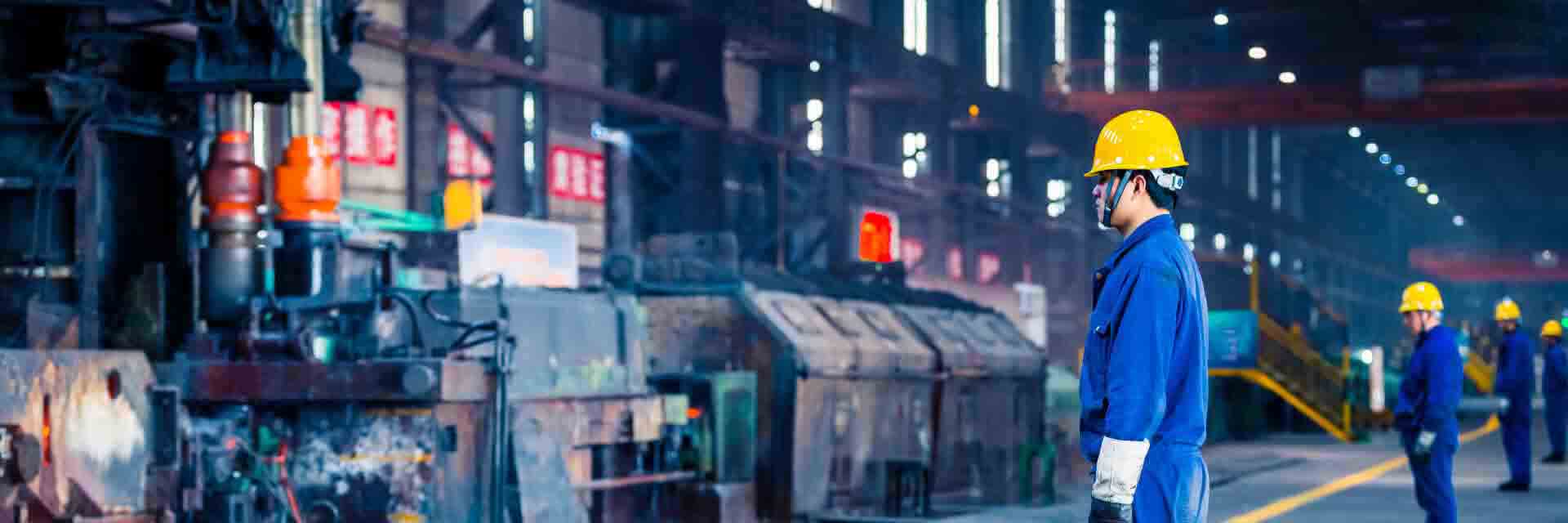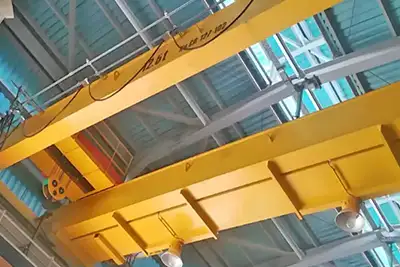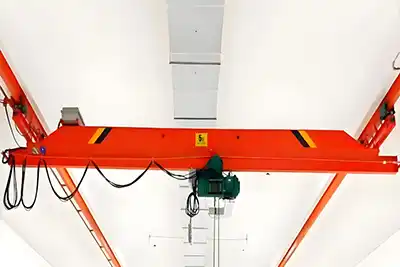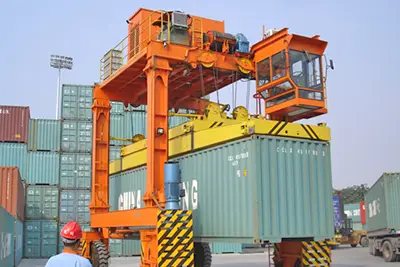Pipe Handling Gantry Crane & Eot Crane: Cost & Lifecycle Analysis
Pipe handling cranes for sale. Which is your best choise, the overehad crane or the gantry crane ? Check Detailed comparison of gantry crane & overhead cranes for pipe handling and storage, focusing on costs, maintenance, installation, and long-term value.
Introduction:Steel Pipe Handling Cranes
Handling steel pipes efficiently requires the right crane. Two popular crane types are commonly used for steel pipe storage and movement: gantry cranes and overhead cranes. Knowing the differences between them helps you pick the best option for your site and operation.
Gantry Cranes
- These cranes have a self-supporting frame that stands on the ground and moves along rails or wheels.
- They are often used in outdoor pipe yards, open storage yards, or sites where no building structure is available to support a crane.
- Gantry cranes can handle long spans and heavy loads, making them suitable for large pipes or bundles.
- Because they don’t require a fixed runway system, they can be moved or relocated if needed.
Overhead Cranes
- Overhead cranes are installed on rails fixed to the building’s columns or beams, or on elevated runways inside warehouses or covered storage areas.
- They lift pipes from above, which helps keep the floor clear and reduces obstruction for other equipment or workers.
- Overhead cranes are ideal for indoor pipe handling, where space is limited or protection from weather is necessary.
- They usually require a solid foundation and building structure capable of supporting the runway beams.
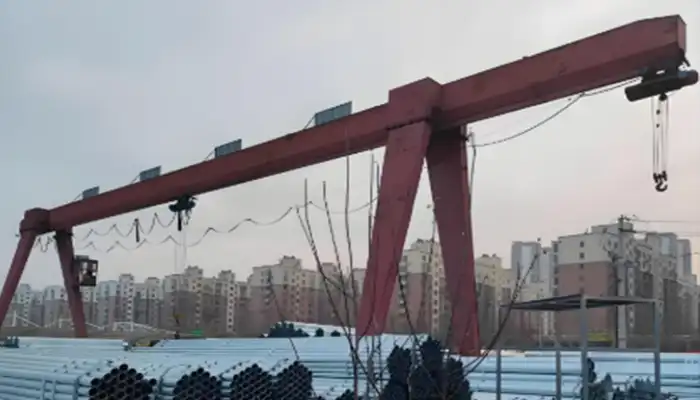
Why Cost Analysis Matters
Choosing a steel pipe handling crane isn’t just about the initial purchase price. The total cost of owning and operating the crane over its lifetime is what really impacts your budget. Here are the key cost areas to consider:
Upfront Purchase Price
- Price varies depending on crane type, capacity, span, and additional features.
- Gantry cranes sometimes cost more initially due to the large steel structure needed.
Installation and Foundation Costs
- Overhead cranes need strong runway beams and foundations, which can add significant cost if the building wasn’t designed for it.
- Gantry cranes usually require rails and ground preparation but may avoid costly building modifications.
Maintenance and Repairs
- Both types require regular inspections and upkeep, but outdoor gantry cranes may need more frequent maintenance due to exposure to weather.
- Parts availability and repair complexity can influence downtime and costs.
Operational Expenses
- Energy consumption differs based on crane design and usage patterns.
- Training and labor costs for operators and maintenance teams should also be factored in.
Service Life and Resale Value
- A well-maintained crane can last many years, but some types hold value better when resold.
- Consider how long you plan to use the crane and potential future upgrades.
Why a Detailed Cost Breakdown Helps
Without a clear understanding of these costs, you risk choosing a crane that fits your immediate budget but becomes expensive to run or maintain later. A thorough cost breakdown lets you:
- Compare gantry and overhead cranes fairly.
- Match the crane choice to your site layout, pipe sizes, and handling frequency.
- Avoid hidden costs that slow down your operation or increase expenses.
Taking the time to analyze costs now saves you money and headaches down the road. It also helps you plan for a smooth, efficient pipe handling system.
Upfront Costs
Initial Purchase Price Comparison
When planning to buy a steel pipe handling crane, the upfront cost is usually the first thing you notice. But don’t let price alone decide. Here’s what typically affects the price difference between gantry and overhead cranes:
- Gantry cranes often have higher initial costs because they include a large steel frame, legs, and sometimes wheels or rails. This structure must be strong enough to support heavy pipes and withstand outdoor conditions if used outside.
- Overhead cranes tend to have lower purchase prices for the crane itself since they rely on existing building structures or runway beams for support. However, if your building isn’t ready for a crane, runway and support beam installation adds to the cost.
Equipment Specifications Influencing Cost
Several technical factors influence the price of either crane type:
- Lifting Capacity:
Heavier loads require more robust components — stronger hoists, thicker girders, and reinforced structures. A 20-ton crane will cost significantly more than a 5-ton one. - Span Length:
The wider the span (distance between supports), the larger and heavier the crane girders need to be. This increases material and fabrication costs. - Height and Hook Lift:
Higher lifting heights or longer hook travel require special design considerations, such as taller structures for gantry cranes or additional motor power. - Speed and Precision Features:
Faster trolley or bridge speeds, variable speed drives, and advanced controls add to the price but improve efficiency.
Customization and Optional Add-Ons Impact
Every steel pipe handling operation has unique needs. Customizing a crane can affect upfront costs:
- Special Hooks and Lifting Attachments:
Magnets, clamps, or grabs designed specifically for different pipe sizes and weights may come at extra cost. - Weather Protection:
For outdoor gantry cranes, weatherproof paint, corrosion-resistant materials, and protective covers increase the initial investment. - Automation and Safety Features:
Adding remote controls, limit switches, overload protection, or anti-sway systems can raise the price but improve safety and ease of operation. - Foundation and Rail Systems:
For gantry cranes, rails must be laid out and aligned precisely, which involves cost beyond the crane structure itself. - Power Supply and Electrical Upgrades:
Sometimes a crane requires special voltage or frequency settings or enhanced wiring, affecting installation and initial price.
Taking the time to detail upfront costs and how different factors influence them helps you plan your budget realistically. It also gives a clear picture of where your money is going and why certain crane options may cost more initially but offer better value over time.
overhead crane for steel pipe handing, types of overhead cranes for your selection
Installation and Foundation Work for Steel Pipe Handling Cranes
Foundation Requirements for Gantry Cranes and Overhead Cranes
When handling heavy steel pipes, a solid foundation is critical for safe and efficient crane operation.
Gantry Cranes for Steel Pipe Handling:
Gantry cranes must have a strong foundation to support both the crane’s weight and the heavy steel pipes it lifts.
- Reinforced concrete pads or steel rails are installed to carry the crane’s legs or wheels.
- The foundation must be perfectly level and stable to prevent misalignment, which can cause uneven load distribution or operational issues.
- Outdoor steel pipe yards may need extra corrosion protection and weather-resistant materials for foundations.
Overhead Cranes for Steel Pipe Handling:
Overhead cranes rely on runway beams attached to the building structure.
- These beams and supporting columns must be engineered to handle dynamic loads created when lifting and moving steel pipes.
- If the existing building wasn’t designed for overhead cranes, structural reinforcement is often required—such as adding steel girders or strengthening concrete supports.
- Proper foundation work is necessary to ensure columns and runway beams remain stable under heavy loads.
Site Preparation and Structural Support Needs
Proper preparation of the site ensures smooth crane operation and reduces risks during pipe handling.
Gantry Crane Site Preparation:
- Rails must be carefully installed and aligned on a firm, level surface, allowing the crane to move steel pipes accurately across the yard.
- The ground surface should be compacted and free of debris or obstacles to prevent derailments or damage.
- Drainage systems are important to avoid water pooling around the crane rails, which can cause rust or instability.
- Sufficient space around the crane track is needed to maneuver long steel pipes safely.
Overhead Crane Site Preparation:
- The building’s runway beams and columns need to be checked for straightness and strength.
- Runway rails must be installed with high precision to maintain smooth crane travel and accurate pipe positioning.
- Electrical power and control wiring must be adapted to the crane’s specifications.
- Clearance under the runway should accommodate the size and length of steel pipes being handled, as well as any additional equipment or personnel.
Installation Complexity and Labor Costs
Installing steel pipe handling cranes involves detailed work and skilled labor, with costs influenced by the crane type:
Gantry Crane Installation:
- Requires assembling large steel frames onsite, often with heavy lifting machinery.
- Precise alignment of rails and crane legs is essential to safely handle heavy pipes without sway or misbalance.
- Outdoor conditions such as weather or uneven terrain may increase installation time and labor costs.
- Generally involves longer installation periods due to size and complexity.
Overhead Crane Installation:
- If a suitable runway system is already in place, installation can be relatively quick.
- Mounting the crane, installing the hoist, and wiring controls are major tasks.
- Structural upgrades to the building (if needed) can significantly increase installation costs and project length.
- Electrical setup requires certified technicians to meet safety standards, especially when handling heavy steel pipes.
For steel pipe handling, the foundation and installation steps differ significantly between gantry and overhead cranes. Gantry cranes demand robust ground support and careful rail installation in open yards, while overhead cranes depend heavily on the building’s runway beams and structural integrity. Both installations require experienced labor to ensure the crane operates safely and efficiently when moving heavy steel pipes.
Maintenance and Operational Expenses
Routine Maintenance Schedules and Costs
Proper maintenance keeps your steel pipe handling cranes running smoothly and extends their lifespan. However, maintenance needs and costs differ between gantry and overhead cranes:
Gantry Cranes:
- Typically require more frequent inspections and servicing, especially if used outdoors where weather, dust, and corrosion are factors.
- Regular tasks include checking wheels and rails for wear, lubricating moving parts, inspecting structural welds and bolts, and servicing hoists and electrical systems.
- Outdoor exposure may require additional surface treatment or repainting to prevent rust.
- Maintenance costs can be higher due to harsher operating environments and larger structural components.
Overhead Cranes:
- Maintenance is generally more controlled, as these cranes operate indoors or in covered spaces, reducing weather-related wear.
- Routine inspections focus on runway alignment, hoist mechanisms, wire ropes or chains, and electrical components.
- Scheduled lubrication, brake checks, and control system tests are essential to avoid unexpected breakdowns.
- Maintenance costs tend to be lower than gantry cranes but still require consistent attention to ensure safety and reliability.
Spare Parts Availability and Replacement Costs
Availability of spare parts and their cost impacts crane downtime and budget:
For Gantry Cranes:
- Due to their larger and often customized structures, some parts like wheels, rails, and structural components may have longer lead times or higher costs.
- Standardized parts such as hoists, motors, and electrical components are usually readily available but can be expensive due to heavy-duty specifications for steel pipe handling.
- Stocking critical spare parts on-site can reduce downtime but requires investment in inventory management.
For Overhead Cranes:
- Spare parts for hoists, controls, and wire ropes are generally standardized and widely available.
- Replacement parts tend to be less expensive than gantry crane structural components.
- Working with a reliable crane supplier or manufacturer can ensure quick access to needed parts, minimizing downtime.
Downtime Implications and Operational Efficiency
Downtime during maintenance or unexpected failures can have a direct impact on steel pipe handling productivity and costs:
Gantry Crane Downtime:
- Because gantry cranes often handle large pipe bundles outdoors, any breakdown can halt significant portions of pipe movement and storage.
- Repairs can take longer due to heavy structural components and exposure to weather conditions.
- Preventive maintenance is crucial to avoid costly unplanned outages, but even scheduled maintenance may require planned downtime that impacts yard operations.
Overhead Crane Downtime:
- While generally quicker to repair, overhead crane downtime can disrupt indoor pipe handling processes, affecting loading/unloading and manufacturing workflows.
- Because overhead cranes often operate in controlled environments, failures due to environmental factors are less common, improving overall reliability.
- Efficient maintenance planning, such as off-shift servicing, helps minimize operational interruptions.
Maintenance and operational expenses are ongoing costs that significantly affect the total cost of ownership for steel pipe handling cranes. Gantry cranes typically face higher maintenance demands and costs due to outdoor conditions and heavier structures, while overhead cranes benefit from indoor protection and often lower upkeep costs. Both require regular, proactive maintenance and quick access to spare parts to keep downtime—and related losses—to a minimum.
Lifecycle Value and Total Cost of Ownership (TCO)
Expected Service Life and Durability Considerations
The lifespan of your crane affects how cost-effective it is over the years.
Gantry Cranes:
- Built with heavy steel structures, gantry cranes are designed for durability, often lasting 20 years or more with proper maintenance.
- Outdoor exposure means they face challenges like corrosion, weather wear, and potential foundation settling, which can shorten service life if not properly managed.
- Regular inspections, repainting, and protective treatments are essential to maintain structural integrity.
- Durable components like hoists and motors can be replaced to extend overall crane life.
Overhead Cranes:
- Typically used indoors or under shelter, overhead cranes generally experience less environmental stress, often resulting in longer service lives, sometimes exceeding 25 years.
- Building structure quality also impacts lifespan, as runway beams must remain strong and aligned.
- Routine preventive maintenance plays a key role in preventing premature failures of critical parts such as wire ropes, brakes, and control systems.
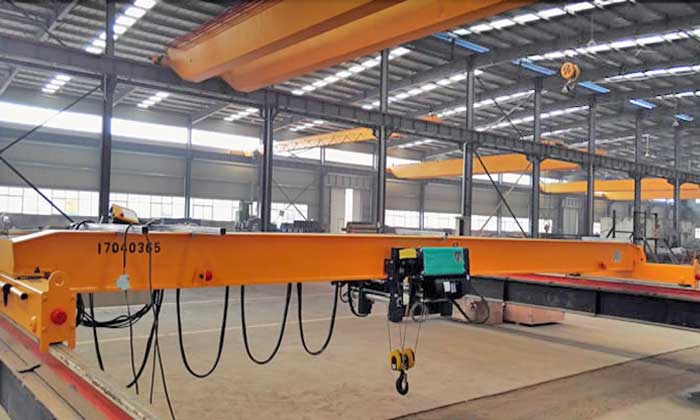
Low energy consuption single girder overhead crane with European style low headroom hoist
Energy Consumption and Operating Costs Over Time
Energy use is a significant operational expense that can add up over a crane’s working life.
Gantry Cranes:
- Because gantry cranes often move across long outdoor yards, their motors can consume more power during travel and lifting, especially if wheels or rails need frequent adjustment.
- Larger, heavier crane structures increase power requirements for movement and load handling.
- Energy-efficient motors and variable frequency drives (VFDs) can help reduce consumption but may increase upfront costs.
Overhead Cranes:
- Operating primarily indoors, overhead cranes often have shorter travel distances and lighter structural mass, leading to generally lower energy use per operation.
- Advanced control systems and efficient hoists reduce power consumption, especially during frequent starts and stops common in pipe handling.
- Consistent electrical supply and reduced exposure to environmental factors help optimize energy efficiency.
Resale Value and Upgrade Potential
Thinking ahead about resale and upgrade options can improve your total investment returns.
Gantry Cranes:
- Due to their size and customization, gantry cranes may have lower resale value unless there is demand for similar outdoor pipe handling needs.
- Structural components can sometimes be reused or relocated, adding value in specific situations.
- Upgrades like improved hoists, automation controls, or weatherproofing can extend usefulness but involve additional cost.
Overhead Cranes:
- Overhead cranes tend to hold resale value better, particularly if they use standardized parts and are well-maintained.
- Modular designs allow easier upgrades, such as adding remote controls, automation, or safety systems.
- Buyers often look for cranes compatible with existing runway infrastructure, increasing marketability.
Total cost of ownership isn’t just about initial price — it includes durability, operating costs, and what you can recover or upgrade later. Gantry cranes offer robust durability for outdoor pipe yards but may face higher energy use and maintenance. Overhead cranes provide efficient, long-lasting service indoors, with better resale and upgrade prospects. Evaluating lifecycle value helps you make a balanced choice that fits your steel pipe handling needs and budget over time.
Application-Specific Cost Factors
Impact of Pipe Storage Layout and Handling Frequency
The way your steel pipes are stored and how often they’re moved can greatly influence which crane type makes the most sense financially.
Pipe Storage Layout:
- Linear yards or long rows: Gantry cranes are ideal because they can travel along rails outdoors, covering large distances efficiently.
- Compact or multi-level indoor storage: Overhead cranes work better here since they move along building runways and can reach confined spaces with precision.
- Complex layouts with frequent direction changes might require more sophisticated crane controls, increasing costs.
Handling Frequency:
- For high-frequency handling, reliability and ease of maintenance become critical to minimize downtime and operational costs.
- Overhead cranes usually offer smoother operation for repetitive indoor tasks, making them cost-effective when pipe handling is constant.
- Gantry cranes are well-suited for less frequent but heavy-duty movements over large outdoor areas.
Environmental Considerations: Indoor vs. Outdoor Use
Where you operate your crane directly impacts maintenance, durability, and initial investment.
Outdoor Gantry Cranes:
- Must withstand weather extremes like rain, snow, wind, and temperature swings.
- Foundations and structural materials require weatherproof coatings and corrosion-resistant features.
- Electrical components need to be sealed or housed in protective enclosures to prevent damage.
- These factors increase upfront costs and ongoing maintenance expenses.
Indoor Overhead Cranes:
- Benefit from climate-controlled environments, reducing corrosion and wear.
- Electrical systems and controls have longer lifespans due to lower exposure to dust and moisture.
- Usually require less frequent painting or structural repairs, lowering maintenance costs.
Space Constraints and Their Influence on Crane Choice and Costs
The physical space available in your facility or yard can drive your crane selection and associated costs.
Limited Vertical or Horizontal Space:
- Overhead cranes excel in facilities where floor space is at a premium since they utilize the overhead area without blocking ground operations.
- Low ceiling heights may require customized crane designs, such as low headroom hoists, which can increase cost.
Wide Open Outdoor Spaces:
- Gantry cranes work well in expansive pipe yards where there is ample room for rail installation and crane movement.
- If space is very large, multiple gantry cranes or specialized double-girder configurations might be needed, raising capital and maintenance costs.
Obstacles and Access Routes:
- Complex layouts with obstructions may favor overhead cranes for their ability to precisely position loads above the workspace.
- Gantry cranes need clear rails and unobstructed paths, so obstacles can increase groundwork and installation costs.
Your specific pipe storage conditions and handling needs heavily influence which crane type is most cost-effective. Gantry cranes fit well with large outdoor pipe yards and less frequent, heavy lifts but come with higher environmental protection and installation costs. Overhead cranes are generally better for indoor facilities with space limitations and high-frequency handling, offering lower maintenance and longer equipment life. Evaluating these application-specific factors ensures your investment matches real operational demands and budget constraints.
Summary Comparison Table
Before making a final decision between gantry cranes and overhead cranes for steel pipe handling, it helps to have a clear, side-by-side comparison of their key cost factors. The table below summarizes upfront costs, operational expenses, and other important considerations to give you a quick overview for easy reference.
| Cost Factor | Gantry Cranes | Overhead Cranes |
|---|---|---|
| Initial Purchase Price | Generally higher due to large steel structure and outdoor durability requirements. | Usually lower if existing runway beams are available; custom buildings increase cost. |
| Foundation & Installation | Requires strong concrete pads or rails; complex site prep and alignment; higher labor costs. | Depends on building structure; may need reinforcement; quicker installation if runway exists. |
| Maintenance Expenses | Higher due to outdoor exposure—corrosion, rail upkeep, weatherproofing. | Lower; indoor use reduces wear and tear; easier access for routine servicing. |
| Spare Parts Availability | Custom parts like wheels and rails may have longer lead times; hoists and controls usually standard. | Standardized parts widely available; faster replacement reduces downtime. |
| Energy Consumption | Higher due to heavier structure and longer travel distances. | Generally lower energy use with shorter travel and lighter structure. |
| Service Life | 15–20+ years with diligent maintenance; outdoor wear can reduce lifespan. | 20–25+ years typical; indoor environment extends durability. |
| Resale and Upgrade Potential | Lower resale due to customization; upgrades possible but costly. | Better resale value; modular upgrades easier and more cost-effective. |
| Environmental Suitability | Best for outdoor yards with heavy, infrequent lifting. | Ideal for indoor or sheltered spaces with frequent pipe handling. |
| Space Requirements | Needs ample outdoor space and clear rail paths. | Suited for limited floor space; uses overhead space efficiently. |
| Operational Downtime Impact | Potentially longer downtime due to complex repairs and weather delays. | Generally shorter repair times; better uptime for frequent handling. |
This comparison highlights how each crane type performs across different cost and operational categories. Keep in mind your specific pipe storage layout, environmental conditions, and handling needs when using this table as a guide.
Conclusion
Making the right choice between gantry and overhead cranes requires understanding not only the upfront costs but also the long-term operational impacts. Here are some key points to keep in mind:
- Cost Advantage and Trade-offs:
Gantry cranes typically involve a larger initial investment and higher ongoing maintenance costs because they are built to endure outdoor conditions and cover large areas. However, they provide excellent flexibility for heavy, infrequent pipe movements over wide yards. Overhead cranes, meanwhile, are generally less expensive to install and operate indoors, offering better energy efficiency and longer service life in controlled environments. - Choosing Based on Application:
If your steel pipe storage involves a large outdoor yard with heavy loads and relatively low handling frequency, gantry cranes are likely the more practical solution despite their higher costs. Conversely, overhead cranes are usually the best fit for indoor facilities or compact yards where pipe handling is frequent and precise, and space is limited. - Balancing Upfront and Long-Term Costs:
Don’t base your decision solely on the purchase price. Consider total cost of ownership—including energy use, maintenance, downtime, and potential resale value. Investing more upfront in durable, efficient equipment can save significant money and headaches down the line.
By carefully evaluating your operational needs against the cost factors outlined above, you can select the crane system that delivers the best balance of performance, reliability, and value for your steel pipe handling operations.

